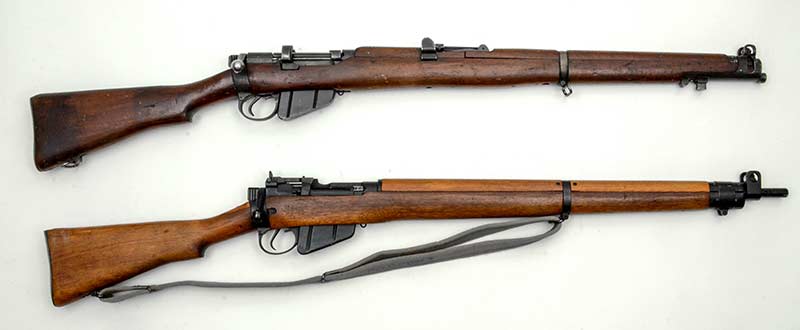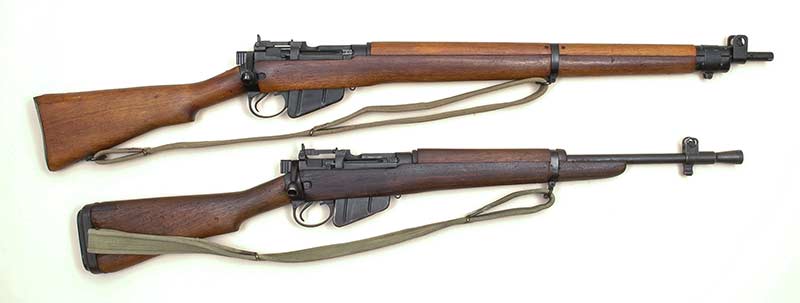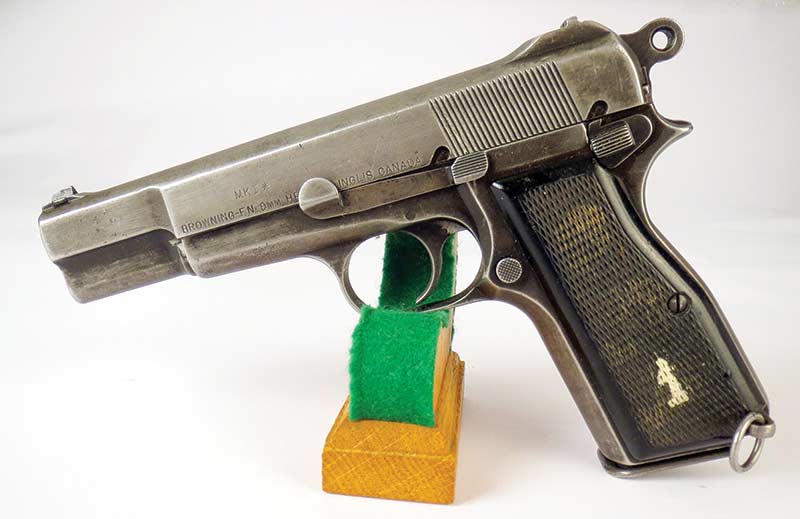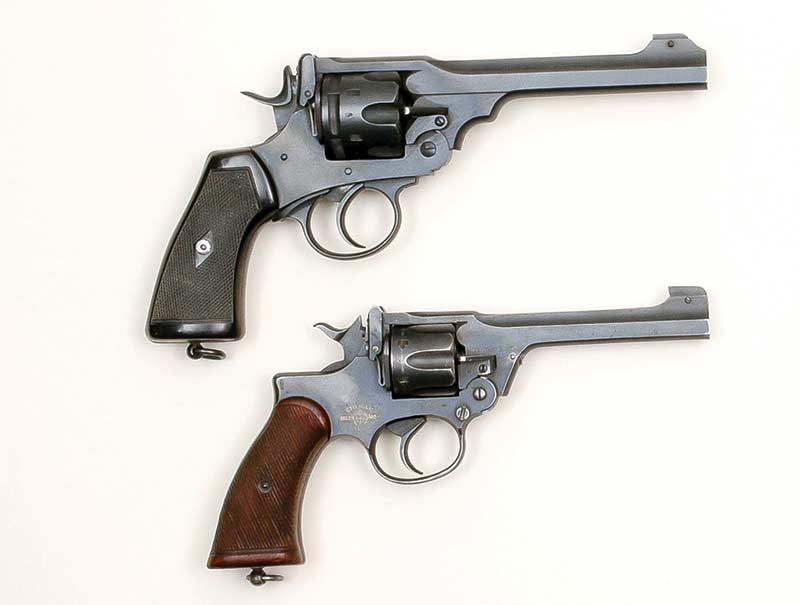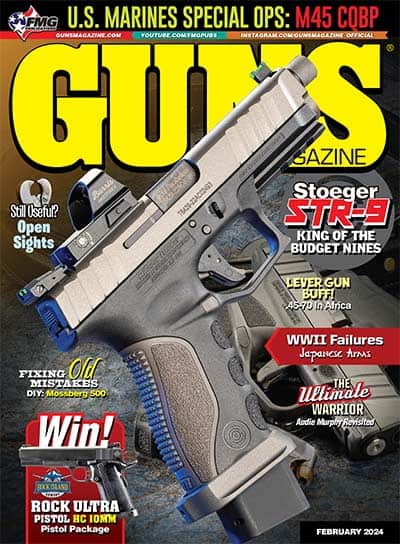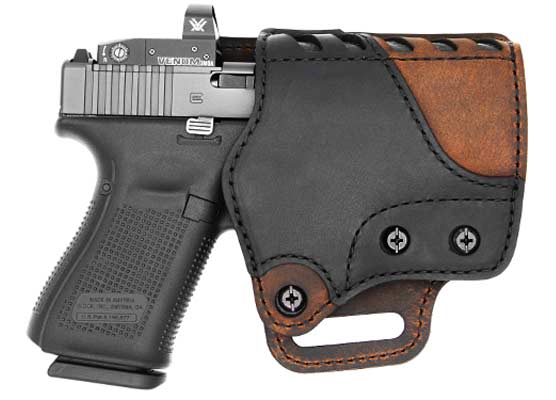British WWII Infantry Small Arms
"Plug Ugly" But Effective
If any phrase could be used to collectively describe Great Britain’s WWII small arms, it would be “Plug Ugly!” Be that as it may, I must paraphrase Forrest Gump’s famous saying, “Ugly is as ugly does.” Many high-ranking British officers were found wanting between 1939 and 1945, but the everyday “Tommy” was well respected by allies and enemies alike, regardless of how ugly his weapons were. The same goes for Commonwealth sidekicks from Canada, Australia, New Zealand, India and Poland who fought beside them.
The ‘Smile’
The Brits used three basic infantry rifles in World War II, all chambered for their famous .303 cartridge, which actually was introduced with black powder in the late 1880s. By World War II, its standard ballistics were a 174-grain FMJ bullet moving at about 2,450 fps. When they declared war on Germany in 1939, their standard army rifle was the same Short Magazine Lee-Enfield (SMLE) No. 3 used in World War I. Barrel length was 25″ with full-length stock ending with a steel cap. Cartridge capacity was 10 rounds in a detachable box magazine although loading was performed with five round stripper clips. The rear sight was an open type, with graduations to 2,000 yards with a post front sight protected by “wings.” Weight was 9 ½ lbs. based on the single sample in my own collection.
The SMLE was produced by the millions in factories in England, India and Australia and surrendered to Axis nations by the hundred thousands during Great Britain’s many defeats early in the 1940s. Even in 1945 at war’s end, many of their combat troops were still packing SMLEs.
Shortly after war was declared, a plan to remodel SMLE No. 3s was completed but none reached troops until 1942. This was the No. 4 MK 1, which stayed in British service through the Korean War and several colonial revolutions until replaced by semi-autos circa 1957. The 10-round box magazine was retained as were barrel length and weight but sights were changed from open to peep rear graduated to 1,300 yards. Front sights remained essentially the same. Later, to save manufacturing time, a simple two-leaf rear peep replaced the long distance sight. An interesting aside is there was also a No. 4 Mk I produced in Canada and the United States by Savage. Another trait retained with the No. 4 Mk I was the two-piece stock. The buttstock was retained with a metal band and were made in different lengths so rifles’ lengths of pull could be fitted to individuals.
A sniper version of No. 4 Mk I’s was devised using a 4X No. 32 scope in very strong and heavy mounts. My No. 4 Mk I sniper weighs 11 ¼ lbs. To help shooters’ eyes to align with the scope, a wooden cheek rest was affixed atop buttstocks. Wisely, the Brits’ No. 32 scopes had both windage and elevation adjustments unlike most World War II German scopes, which only had elevation adjustments, and Japanese scopes, which had no adjustments at all.
Great Britain’s third infantry rifle, the.303 Pattern 1914 (P14), also dated from World War I. It was also designed in their Enfield facility but ironically all were produced in the United States by Winchester, Remington and Eddystone (a Remington affiliate). Those three factories made 1.2 million of these .303 rifles in merely 15 months of production. The P14 also had peep rear sights graduated to 1,650 yards but their integral magazines held only five rounds. Barrels were 26″ and the weight of my Winchester-made sample is 10 lbs. According to my research, the British never issued P14s in World War I, which seems very odd, as they were desperate for arms. However, for sure P14s were pulled from stocks and used in the Second World War, mostly being issued to foreign-born troops such as the Free Poles who fought well with British equipment in Italy.
Carbines
The Brits issued two carbines in World War II. One was a true carbine based on the No. 4 Mk I but the other was classed as a “machine carbine.” This was their famous 9mm STEN gun, more commonly called a submachine gun. Mine is the No. 2 version with wire buttstock and 7 ¾” barrel. It weighs a mere 7 ¼ lbs. Some experts feel it was one of the most practical submachine guns ever issued to troops. It could be disassembled into three parts in seconds for cleaning or packing. Furthermore, the side-mounted 32-round magazine allowed combatants to get closer to the ground than was possible with other submachine guns with long magazines hanging under the receiver. STEN guns may look shoddily-made because they were — costing only about $10 to produce.
The other British carbine is the No. 5 .303 “Jungle Carbine,” distinctive by the flared flash suppressor. Barrel length was 20.5″ and mine weighs 7 ¾ lbs. Buttstock and sights were essentially the same as with the No. 4 Mk I. However, the forestock was round ahead of the barrel band, slightly resembling a sporting rifle stock. In an effort to reduce weight, lightening cuts were made in the No. 5 action and even the bolt handle knob was hollow. Supposedly these cuts result in an affliction specific to the No. 5 called the “wandering zero.” Mine has not shown signs of this trait but I’ve not shot it in long strings. Perhaps zero will wander if the barrel gets hot enough. Although its name indicates it was only intended for the China/Burma/India Theaters of action, according to my research, No. 5s were also issued to a Polish Parachute Regiment.
Handguns
Now let’s move onto handguns. Discounting American-made Smith & Wesson revolvers and perhaps imports from other nations, I count three basic handguns carried by British officers and certain troops such as machine gun and tank crews. The standard-issue revolver starting in 1928 was the Enfield No. 2 chambered for their .38-200 cartridge. Although underpowered, the No. 2 revolver is a delightful little handgun. It is of break-open design with a six-round cylinder capacity and 5″ barrel. Mine weighs a mere 1 ¾ lbs. It functions as both single- and double-action, and there was also a double-action-only version. Sights were a simple notch in the barrel latch but front sights were pinned so different heights could be used for zeroing.
Actually, the .38-200 was nothing more than the American .38 S&W. There was an interesting incident early in World War II concerning the Brit’s .38-200 load. Its bullet was lead, which was proscribed by the international rules of warfare. This outraged the Germans so the British went to a 178-grain full metal jacket bullet. The cartridge then became the .380 Revolver. Regardless of 200- or 178-grain bullets, velocity was only about 650 fps. I put a surplus U.S. Army helmet on a post and hit it from 10 yards with my Enfield No. 2 using a handload duplicating the .38-200. The helmet didn’t even jump off the post and was barely dented by the bullet.
The other revolver issued by the British was their Webley Mk VI. It had been introduced in 1916 as a renovation of the basic .455 Webley from 1887. Whereas the earlier Webleys had shorter barrels, the MK VI barrel was 6″. Also top-break with a six-round cylinder and dual single- and double-action function, Mk VI is a large, robust revolver. Mine weighs 2 ½ lbs. Sights were essentially the same as with the Enfield No. 2, just larger. By World War II, the .455 Webley was loaded with 265-grain full metal jacket bullets with nominal velocity of 620 fps.
During the war, the British army finally decided to join the 20th century in regards to handguns. This was due to the Canadian firm of Inglis reverse-engineering the Browning 9mm Hi-Power — aka Model 1935 as made by FN in Belgium, then-occupied by the German Army. These Inglis Hi-Powers were a little more crudely finished than Belgian ones but were perfectly functional. They had a 4.63″ barrel and my sample weighs 2 lbs. Their magazine capacity of 13 rounds was surely appreciated by combat troops. Speaking of which — Inglis Hi-Powers were not issued to the rank-and-file British fighting men. They were only issued to Commando units and Parachute troops.
Accuracy Without The Power
As I’ve mentioned several times, I have shooting samples of all the British weapons mentioned herein. I consider my .303 rifles and No. 5 carbines perhaps not as accurate as U.S. Model 1903/1903A3 bolt actions but likely on par with un-tuned M1 Garands. Their handguns are just as accurate as American revolvers as is the Inglis Hi-Power to our Model 1911/1911A1. They were just less powerful.
By the way, British troops proved what was implied in the first paragraph … guns don’t have to be pretty to win wars.
